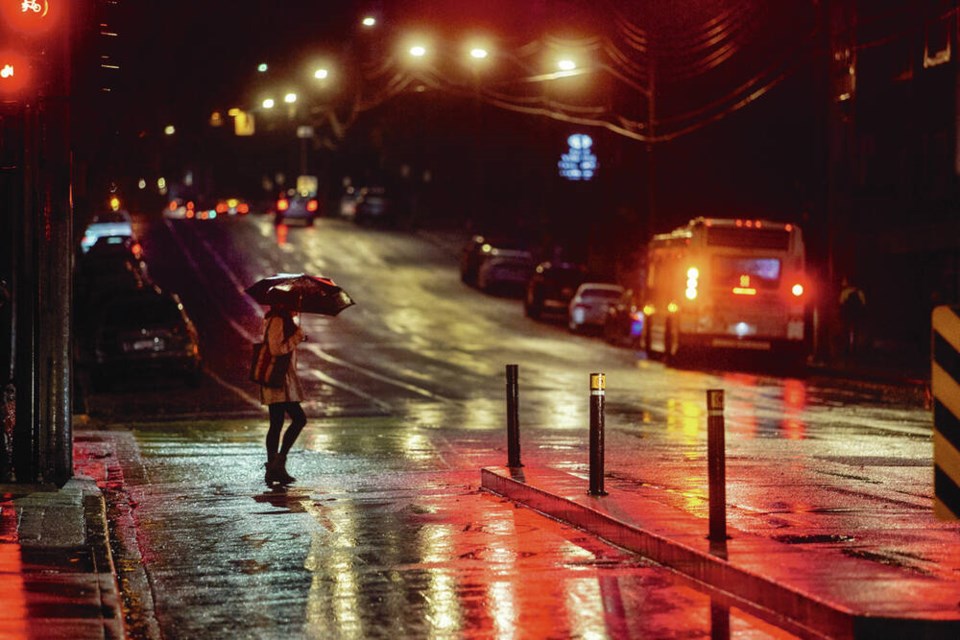One of the top 10 complaints I receive is from drivers about “invisible” cyclists and pedestrians. They’re the people who venture out at night, dressed in dark clothing or in the case of cyclists, having no light, front or back, on their bike while also wearing dark clothing. I have a lot of sympathy for drivers on this one.
Many streets in the CRD don’t have sidewalks and I’ve been surprised many times by dark clad apparitions popping up a few feet away from me as I drive by. Could I have stopped if they had suddenly appeared in front of me?
Twenty per cent of the people killed in crashes in sa国际传媒 each year are pedestrians. ICBC says a pedestrian is most likely to be struck on a Thursday or Friday, between 3 and 6 p.m., during the months of October to February, at an intersection.
The main causes of pedestrian accidents are: driver inattention; failing to yield and; weather. I can’t dispute their research, but I wonder about those night time and bad weather cases and how much pedestrian invisibility played a role.
Back in 1937 two guys named Roper and Howard conducted road safety visibility experiments around driver “expectancy” — in other words, you’ll see someone sooner along a darkened roadway if you expect them to be there.
They proved that a driver who was expecting pedestrians was able to detect a crash test dummy at twice the distance compared to times they were not expecting to see anyone.
For pedestrians, anything that increases driver awareness of your presence is a good thing. There is a huge amount of reflective gear and light emitting diode (LEDs) tech on the market today and it’s cheaper than ever. Even a small flashing light can alert an oncoming driver much sooner and based on what Roper and Howard learned. Who wouldn’t want to double their safety odds?
Pedestrians can do a lot to minimize the danger. Remember, whether you’re legally right or wrong in your actions prior to being struck, you’re going to come out on the losing end of the incident physically.
First, resist the urge to walk out until you are sure the driver has seen you.
It’s difficult to judge the speed of an oncoming car at night based solely on approaching headlights. It’s even more difficult in rain and fog.
Second, don’t get distracted by the weather. When it’s raining, pedestrians often use a “duck and run” method to cross a road. They’re anxious to get out of the wet, so they put their heads down, often using only their peripheral vision or at best a glance, while running into the path of cars.
Third, pedestrians frequently overestimate the distance they believe other drivers can see them. Don’t assume anything when you step out on the road, especially at night.
Fourth, if there are no sidewalks, walk on the left side of the road facing traffic. It’s way easier to jump out of the way of an oncoming car. It’s pretty well impossible to react in time to one coming up from behind.
For drivers the best advice is to slow down particularly in residential areas which often have much less street lighting than in commercial areas. Start adopting an “expect to see them” attitude.
Day or night, pedestrians are often hit in crosswalks. One of the major driving mistakes happens on a two-laned roadway when vehicle “B” passes vehicle “A” which has stopped to allow a pedestrian to cross. Passing a vehicle already stopped for a pedestrian is an offence under our Motor Vehicle Act and can have cataclysmic results.
Driving instructors and test examiners always try to hammer this one home: Never pass or at least use extreme caution when passing a vehicle that has made an unexplained stop. I can think of at least five times in my driving life where I’ve seen this rule violated, one where a pedestrian was seriously injured.
One way drivers can cut down on this risk is for driver “A” to stop well before the crosswalk, even if it seems unnatural. This allows driver “B” a much wider field of view when approaching a crosswalk from an adjacent lane.
Reversing this perspective also works for pedestrians. If one car has stopped for you on a multi-lane roadway, never assume the cars in the other lanes are also going to stop. A car that has stopped with the lane beside it still open is truly a red alert for a pedestrian, even if you’re crossing properly with the signal. Look down the road past the stopped car to ensure nothing else is headed your way.
On average 52 pedestrians are killed each year in sa国际传媒 The simple steps I’ve mentioned here can go a long way to reducing that number.



